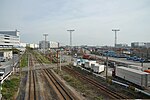Ohi Racecourse
1950 establishments in JapanHorse racing venue stubsHorse racing venues in JapanJapanese sports venue stubsShinagawa ... and 2 more
Sports venues completed in 1950Sports venues in Tokyo

Ohi Racecourse (大井競馬場, Ōi Keiba-jō), also known as Tokyo City Keiba (TCK), is located in Shinagawa, Tokyo, Japan. Built in 1950 for horse racing, on weekends it also hosts one of the largest Tokyo-area flea markets. [1] The racecourse is located near Ōi Keibajō Mae Station on the Tokyo Monorail. The Tokyo City Cup held annually at Santa Anita Park in Arcadia, California honors the partnership between the American racetrack and Ohi Racecourse. In recognition of their relationship, TCK holds "Santa Anita Week" each summer which features the one mile G3 "Santa Anita Trophy".
Excerpt from the Wikipedia article Ohi Racecourse (License: CC BY-SA 3.0, Authors, Images).Ohi Racecourse
Shuto Expressway Route 1 Haneda Line, Shinagawa Katsushima
Geographical coordinates (GPS) Address Nearby Places Show on map
Geographical coordinates (GPS)
| Latitude | Longitude |
|---|---|
| N 35.591338888889 ° | E 139.74260833333 ° |
Address
Shuto Expressway Route 1 Haneda Line
140-0012 Shinagawa, Katsushima
Japan
Open on Google Maps











